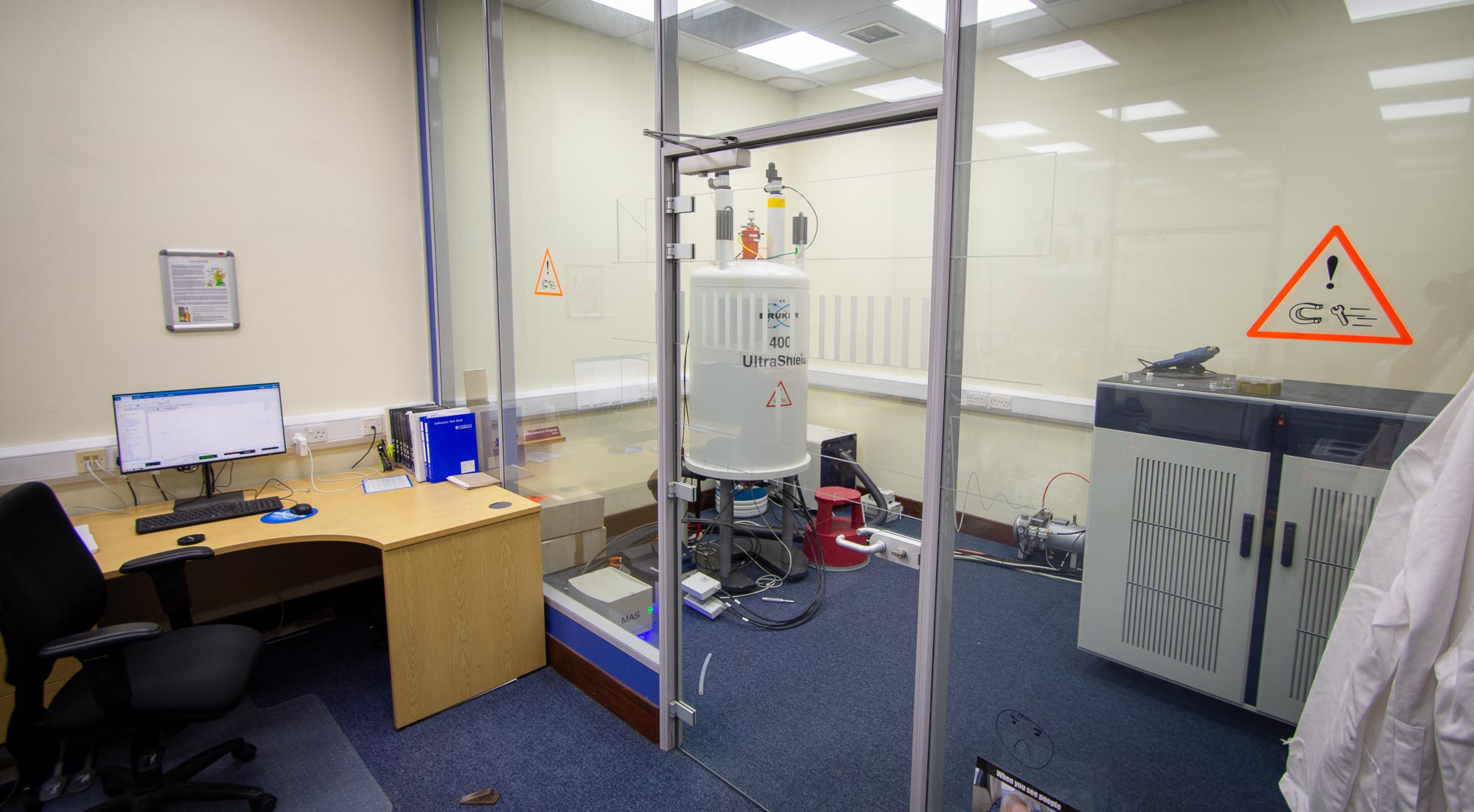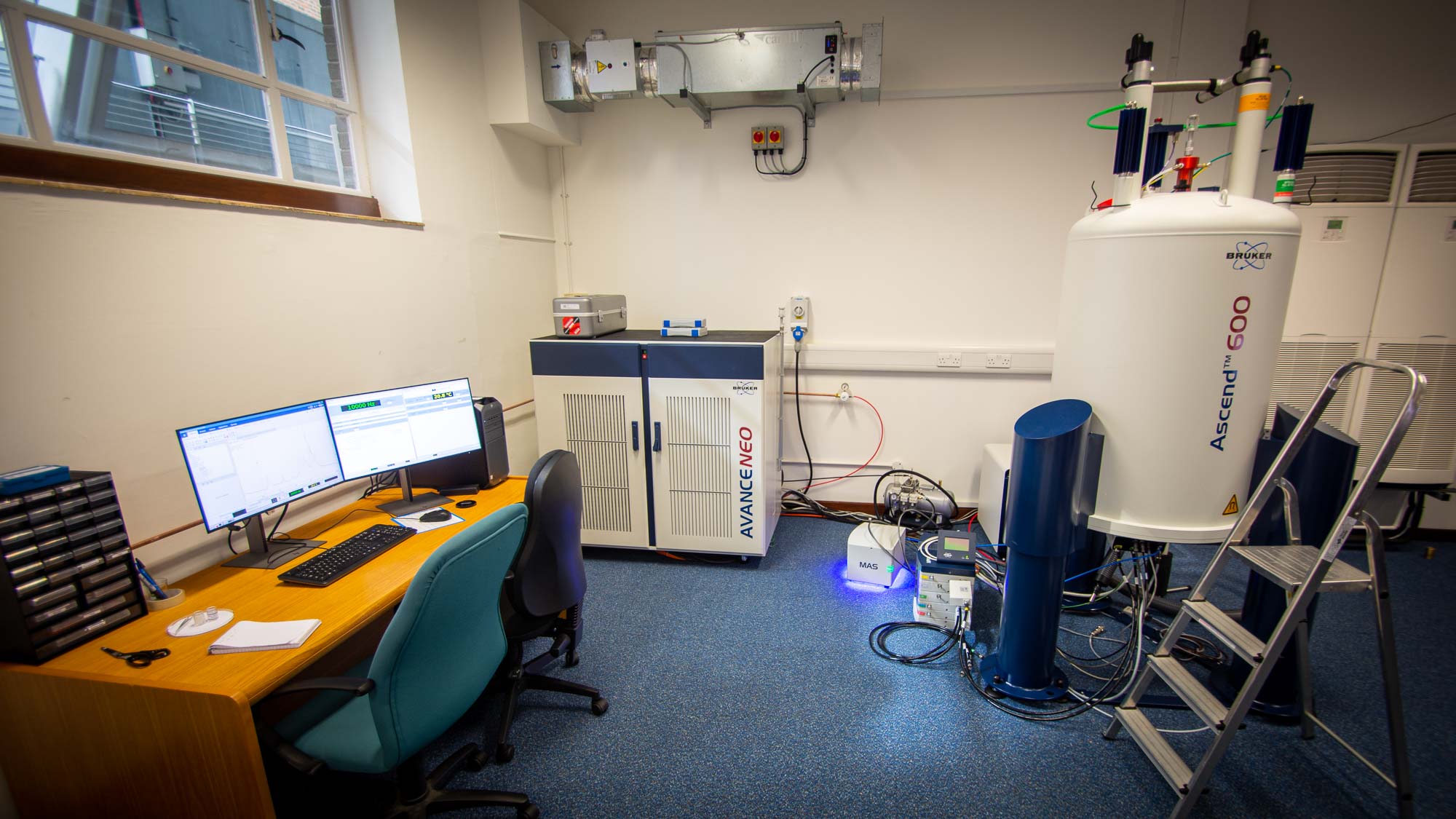
The department of Chemistry hosts a solid-state NMR facility, including two 400 MHz mainly used by the Duer and Forse groups, a 700 MHz, and a 600MHz. Contact Prof. Melinda Duer for solid-state NMR enquiries.
Background
When placed in a strong magnetic field, a magnetic nucleus, such as 1H, 13C or 31P, can absorb, then re-emit an electromagnetic radiation provided it matches its the resonance frequency. The resonance frequency is dependent on both the strength of the magnetic field, and the local enviroment of the nucleus. NMR spectroscopy uses this phenomenon (and a lot of quantum mechanics!) for investigating the structure and dynamics of molecules. Although NMR spectroscopy is commonly used to study molecules and proteins in solution, it can also be used to study solids provided the sample is spun at the so-called magic angle (MAS). Our group has an expertise in solid state NMR spectroscopy (ssNMR) to study biomaterials in their native state.
Selected book
- Solid-State NMR Spectroscopy Principles and Applications; Duer, M. J., Ed.; Blackwell Science Ltd: Oxford, UK, 2001. https://doi.org/10.1002/9780470999394.
NMR instrumentation
Kinchie
Our group mainly uses the departmental 400 MHz wide bore spectrometer in B17, nicknamed 'Kinchie' (formerly 'Glenkinchie'). Kinchie is equipped with a Bruker AVANCE NEO three-channel console, a magic angle spinning (MAS-III) unit, and can operate at temperatures ranging from -60ºC to 80ºC thanks to the BCU-II chiller or the liquid nitrogen dewar. Three probes are dedicated to this instrument:
- 4mm double resonance HX probe (MAS up to 15 kHz)
- 4mm triple resonance HXY probe (MAS up to 15 kHz)
- 7mm double resonance HX probe (MAS up to 7 kHz)

Nessie
A 600 MHz standard bore, nicknamed 'Nessie', has been installed in August. The ERC-funded spectrometer is equipped with a Neo console, and capable of doing both solid-state NMR (MAS-III unit), and solution-state (2H lock and gradient channel) at variable temperatures (BCU-II chiller). Nessie has a range of probes that will immensely boost our group to study biological samples:
- 4 mm HX CP-MAS iProbe for solid state NMR at MAS rates up to 15 kHz
- 5 mm BBI probe for solution state NMR (BBI designed for 1H observation with X-nuclei decoupling)
- 3.2 mm HCP Efree CP-MAS for solid state NMR at MAS rates up to 24 kHz. Efree probes significanly reduce RF heating of salty samples, and will enable the study of samples prepared from physiological conditions.
- 3.2 mm HCN Efree CP-MAS for solid state NMR at MAS rates up to 24 kHz.
- 2.5 mm HX CP-MAS for solid state NMR at MAS rates up to 35 kHz
- 1.3 mm HX CP-MAS for solid state NMR at MAS rates up to 67 kHz, particulaly useful for proton-detected experiments.
- 4 mm HRMAS probe for the high resolution study of viscous liquids and gels, which links the gap between solids and liquids. 13C optimised - 1H with a single axis gradient along the magic angle.

Arran
Our group also has access to a 700 MHz standard bore spectrometer in B14, nicknamed 'Arran'. The higher field and the faster spinning probes of this instrument increases the signal to noise and the resolutio of the spectra obtained with this system. Arran is equipped with a Bruker Avance II three-channel console, a magic angle spinning unit (MAS-III), and can operate at temperatures ranging from -60ºC to 80ºC (BCU-II). Two probes for solid-state samples can be used with this instrument:
- 1.3 mm double resonance HX probe (MAS up to 67 kHz), that can be used for proton-detected experiments
- 3.2 mm triple resonance HCN probe E-free probe (MAS up to 24 kHz), that is particularly adapted to study salty samples.

